Difference between revisions of "Fleshing - Making of leather"
| (5 intermediate revisions by one user not shown) | |||
| Line 4: | Line 4: | ||
| − | When fleshing, connective tissue and meat residue are removed from the [[flesh side]] of the skin. In the past, special tools were used by the [[tanner]]. Nowadays this stage is done with rotating scraping rolls. | + | When fleshing, subcutaneous connective tissue and meat residue are removed with sharp blades from the [[flesh side]] of the skin. In the past, special tools were used by the [[tanner]]. Nowadays this stage is done with rotating scraping rolls. The average weight of a defleshed [[Measures and weights|4,5 m²]] big [[cowhide]] is approx. 25 kilos. |
If you want to remove the skin of an animal yourself, you have to work carefully. Especially if you want to get a complete hide with head, limbs and tail. Without expert advice, it's unlikely that you will get ears, nose or tail undamaged during the first attempt. | If you want to remove the skin of an animal yourself, you have to work carefully. Especially if you want to get a complete hide with head, limbs and tail. Without expert advice, it's unlikely that you will get ears, nose or tail undamaged during the first attempt. | ||
| Line 29: | Line 29: | ||
<p align=center> | <p align=center> | ||
| − | [[bild:800px-Gerber.jpg| | + | [[bild:800px-Gerber.jpg|500px]] |
| − | [[bild:Entfleischen-04.jpg| | + | </p> |
| + | <p align=center> | ||
| + | [[bild:Entfleischen-04.jpg|500px]] | ||
</p> | </p> | ||
<p align=center> | <p align=center> | ||
| Line 37: | Line 39: | ||
<p align=center> | <p align=center> | ||
| − | [[bild:Entfleischen-002.jpg| | + | [[bild:Entfleischen-002.jpg|500px]] |
| − | [[bild:Entfleischen 001.jpg| | + | </p> |
| + | <p align=center> | ||
| + | [[bild:Entfleischen 001.jpg|500px]] | ||
</p> | </p> | ||
<p align=center> | <p align=center> | ||
| Line 48: | Line 52: | ||
</p> | </p> | ||
<p align=center> | <p align=center> | ||
| − | [[bild:Hirngerbung-Enthaaren.jpg| | + | [[bild:Hirngerbung-Enthaaren.jpg|500px]] |
| − | [[bild:Hirngerbung-Enthaaren-Zecke.jpg| | + | </p> |
| + | <p align=center> | ||
| + | [[bild:Hirngerbung-Enthaaren-Zecke.jpg|500px]] | ||
</p> | </p> | ||
<p align=center> | <p align=center> | ||
''When the hair is scraped off, a tick sometimes appears.''<br></p> | ''When the hair is scraped off, a tick sometimes appears.''<br></p> | ||
<p> </p> | <p> </p> | ||
| − | |||
| − | |||
| − | |||
== [[Leather videos|Video]] about the [[leather production]]== | == [[Leather videos|Video]] about the [[leather production]]== | ||
| Line 70: | Line 73: | ||
! bgcolor=#eeeeee | [[Leather production|Process steps in the leather production]] | ! bgcolor=#eeeeee | [[Leather production|Process steps in the leather production]] | ||
|- | |- | ||
| − | | bgcolor=#ffffff align=center | [[storage of leather|storage]] - [[soaking]] - [[Liming - Leather Tanning|liming]] - fleshing - [[Split leather|splitting]] - [[pickling]] - [[Tanning leather|tanning]] - [[neutralising]] - [[Drying leather|withering]] - [[Leather production#Sorting|sorting]] - [[shaving]] - [[Leather production#Dyeing | + | | bgcolor=#ffffff align=center | [[storage of leather|storage]] - [[soaking]] - [[Liming - Leather Tanning|liming]] - fleshing - [[Split leather|splitting]] - [[pickling]] - [[Tanning leather|tanning]] - [[neutralising]] - [[Drying leather|withering]] - [[Leather production#Sorting|sorting]] - [[shaving]] - [[Leather production#Dyeing - Fatliquoring - Re-tanning|dyeing - fatliquoring - retanning]] - [[Drying leather|drying]] - [[finish]] - [[softening]] - [[Leather quality|final check]] |
|} | |} | ||
</center> | </center> | ||
Latest revision as of 18:44, 11 January 2023
When fleshing, subcutaneous connective tissue and meat residue are removed with sharp blades from the flesh side of the skin. In the past, special tools were used by the tanner. Nowadays this stage is done with rotating scraping rolls. The average weight of a defleshed 4,5 m² big cowhide is approx. 25 kilos.
If you want to remove the skin of an animal yourself, you have to work carefully. Especially if you want to get a complete hide with head, limbs and tail. Without expert advice, it's unlikely that you will get ears, nose or tail undamaged during the first attempt.
The raw skin is removed from the slaughter. This step can damage the skin.
The process of fleshing by hand tools.
Tanner with traditional fleshing tools, picture D. Albert, Horb 2006. - Fleshing, historical picture.
The machine fleshing in a tannery by sharp knife rollers.
When the hair is scraped off, a tick sometimes appears.
Video about the leather production
The leather production in a modern tannery.
| Process steps in the leather production |
|---|
| storage - soaking - liming - fleshing - splitting - pickling - tanning - neutralising - withering - sorting - shaving - dyeing - fatliquoring - retanning - drying - finish - softening - final check |
| Tanning methods |
|---|
| Chrome tanning - Vegetable-tanned leather - Synthetic tanning - Tanning with fats and oils |







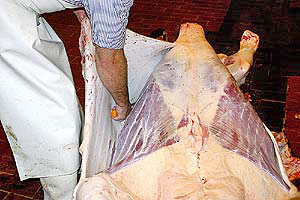
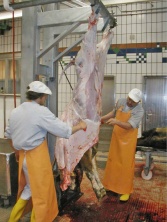
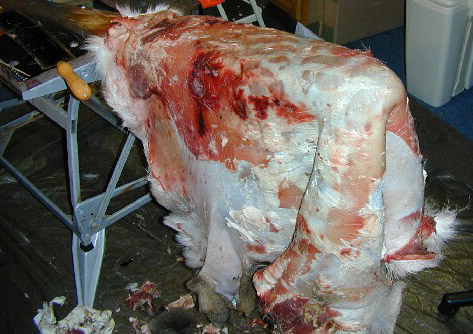
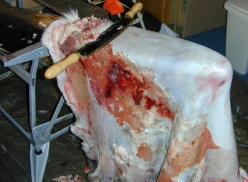
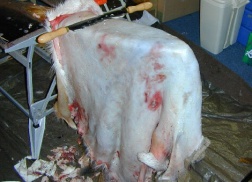
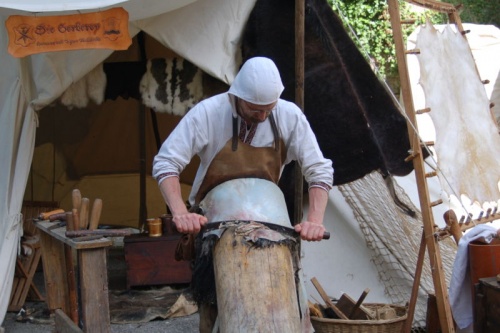
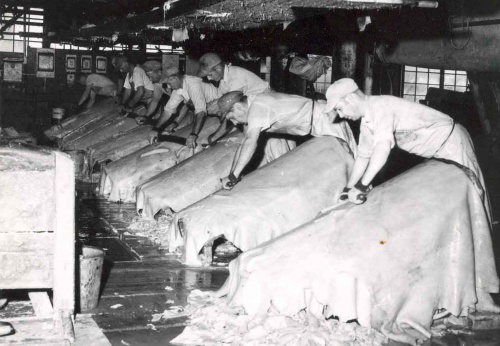
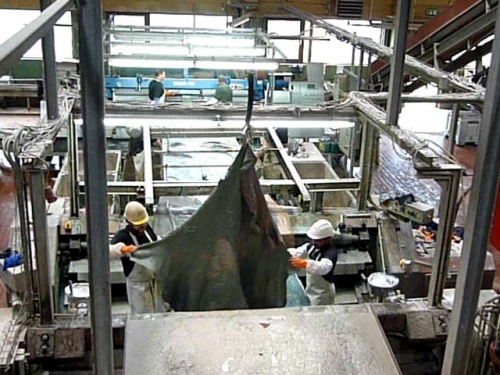
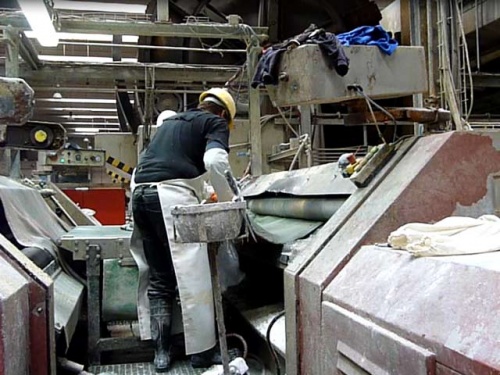
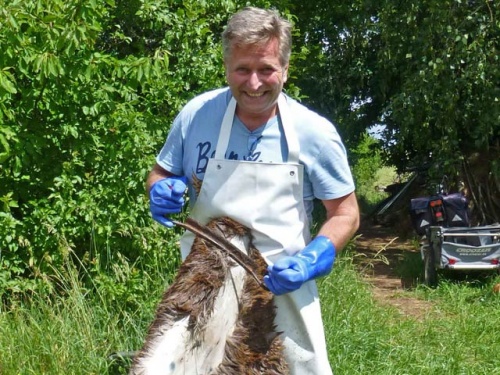
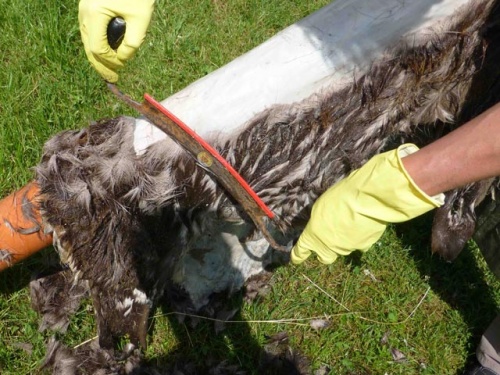
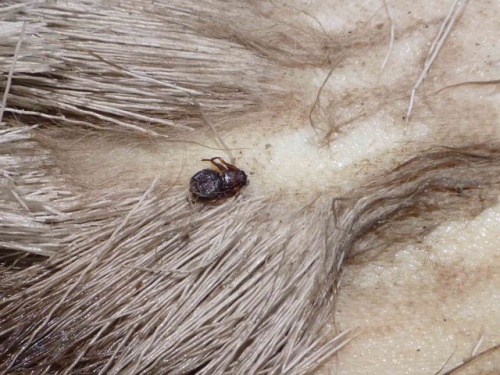

 a kotori web solution
a kotori web solution